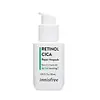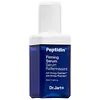What's inside
What's inside
 Key Ingredients
Key Ingredients

 Benefits
Benefits

 Concerns
Concerns

 Ingredients Side-by-side
Ingredients Side-by-side

Water
Skin ConditioningGlycerin
HumectantButylene Glycol
HumectantNiacinamide
SmoothingDibutyl Adipate
EmollientCaprylic/Capric Triglyceride
Masking1,2-Hexanediol
Skin ConditioningHydrogenated Lecithin
EmulsifyingAmmonium Acryloyldimethyltaurate/Vp Copolymer
Helianthus Annuus Seed Oil
EmollientCholesterol
EmollientAllantoin
Skin ConditioningGlycine Soja Oil
EmollientTocopherol
AntioxidantTocopheryl Acetate
AntioxidantSodium Methyl Stearoyl Taurate
CleansingPropanediol
SolventDaucus Carota Sativa Root Extract
Skin ConditioningEthylhexylglycerin
Skin ConditioningAdenosine
Skin ConditioningAsiaticoside
AntioxidantMadecassic Acid
Skin ConditioningCamellia Sinensis Seed Extract
HumectantAsiatic Acid
Skin ConditioningRetinol
Skin ConditioningStearyl Glycyrrhetinate
Skin ConditioningHyaluronic Acid
HumectantMannitol
HumectantCeramide NP
Skin ConditioningBeta-Glucan
Skin ConditioningBeta-Carotene
Skin ConditioningPhytosphingosine
Skin ConditioningBHT
AntioxidantSalicylic Acid
MaskingAcetyl Tetrapeptide-11
Skin ConditioningWater, Glycerin, Butylene Glycol, Niacinamide, Dibutyl Adipate, Caprylic/Capric Triglyceride, 1,2-Hexanediol, Hydrogenated Lecithin, Ammonium Acryloyldimethyltaurate/Vp Copolymer, Helianthus Annuus Seed Oil, Cholesterol, Allantoin, Glycine Soja Oil, Tocopherol, Tocopheryl Acetate, Sodium Methyl Stearoyl Taurate, Propanediol, Daucus Carota Sativa Root Extract, Ethylhexylglycerin, Adenosine, Asiaticoside, Madecassic Acid, Camellia Sinensis Seed Extract, Asiatic Acid, Retinol, Stearyl Glycyrrhetinate, Hyaluronic Acid, Mannitol, Ceramide NP, Beta-Glucan, Beta-Carotene, Phytosphingosine, BHT, Salicylic Acid, Acetyl Tetrapeptide-11
Water
Skin ConditioningMethylpropanediol
SolventGlycerin
Humectant1,2-Hexanediol
Skin ConditioningCaprylic/Capric Triglyceride
MaskingNiacinamide
SmoothingPolyglycerin-3
HumectantBorago Officinalis Extract
EmollientAlgae Extract
EmollientEclipta Prostrata Leaf Extract
Skin ConditioningCyclohexasiloxane
EmollientCentaurea Cyanus Flower Water
Skin ConditioningMelia Azadirachta Leaf Extract
Skin ConditioningMelia Azadirachta Flower Extract
Skin ConditioningAvena Sativa Kernel Extract
AbrasiveCynara Scolymus Leaf Extract
Skin ConditioningPteris Multifida Extract
AntioxidantCoccinia Indica Fruit Extract
Skin ConditioningAloe Barbadensis Flower Extract
EmollientSolanum Melongena Fruit Extract
Skin ConditioningOcimum Sanctum Leaf Extract
Skin ConditioningNymphaea Alba Flower Extract
Skin ConditioningCorallina Officinalis Extract
Skin ConditioningCurcuma Longa Root Extract
MaskingNymphaea Caerulea Flower Water
Skin ConditioningEthylhexylglycerin
Skin ConditioningAdenosine
Skin ConditioningFructooligosaccharides
HumectantHydrogenated Lecithin
EmulsifyingCitrus Aurantium Bergamia Fruit Oil
MaskingBeta-Glucan
Skin ConditioningDisodium EDTA
Polyquaternium-51
Skin ConditioningSodium Hyaluronate
HumectantButylene Glycol
HumectantAmmonium Acryloyldimethyltaurate/Vp Copolymer
Xanthan Gum
EmulsifyingCarbomer
Emulsion StabilisingTromethamine
BufferingInositol
HumectantPropanediol
SolventHydrolyzed Hyaluronic Acid
HumectantDipropylene Glycol
HumectantSodium Palmitoyl Proline
Skin ConditioningLavandula Angustifolia Oil
MaskingCholesterol
EmollientCaprylyl Glycol
EmollientCyanocobalamin
Skin ConditioningGlycine
BufferingAcetyl Glutamine
Skin ConditioningDipalmitoyl Hydroxyproline
Skin ConditioningSodium Cocoyl Alaninate
Serine
MaskingGlutamic Acid
HumectantAspartic Acid
MaskingLeucine
Skin ConditioningAlanine
MaskingLysine
Skin ConditioningArginine
MaskingTyrosine
MaskingPhenylalanine
MaskingProline
Skin ConditioningThreonine
Valine
MaskingIsoleucine
Skin ConditioningHistidine
HumectantCysteine
AntioxidantMethionine
Skin ConditioningAcetyl Hexapeptide-8
HumectantCopper Tripeptide-1
Skin ConditioningHexapeptide-9
Skin ConditioningNonapeptide-1
Skin ConditioningPalmitoyl Pentapeptide-4
Skin ConditioningPalmitoyl Tetrapeptide-7
Skin ConditioningPalmitoyl Tripeptide-1
Skin ConditioningTripeptide-1
Skin ConditioningWater, Methylpropanediol, Glycerin, 1,2-Hexanediol, Caprylic/Capric Triglyceride, Niacinamide, Polyglycerin-3, Borago Officinalis Extract, Algae Extract, Eclipta Prostrata Leaf Extract, Cyclohexasiloxane, Centaurea Cyanus Flower Water, Melia Azadirachta Leaf Extract, Melia Azadirachta Flower Extract, Avena Sativa Kernel Extract, Cynara Scolymus Leaf Extract, Pteris Multifida Extract, Coccinia Indica Fruit Extract, Aloe Barbadensis Flower Extract, Solanum Melongena Fruit Extract, Ocimum Sanctum Leaf Extract, Nymphaea Alba Flower Extract, Corallina Officinalis Extract, Curcuma Longa Root Extract, Nymphaea Caerulea Flower Water, Ethylhexylglycerin, Adenosine, Fructooligosaccharides, Hydrogenated Lecithin, Citrus Aurantium Bergamia Fruit Oil, Beta-Glucan, Disodium EDTA, Polyquaternium-51, Sodium Hyaluronate, Butylene Glycol, Ammonium Acryloyldimethyltaurate/Vp Copolymer, Xanthan Gum, Carbomer, Tromethamine, Inositol, Propanediol, Hydrolyzed Hyaluronic Acid, Dipropylene Glycol, Sodium Palmitoyl Proline, Lavandula Angustifolia Oil, Cholesterol, Caprylyl Glycol, Cyanocobalamin, Glycine, Acetyl Glutamine, Dipalmitoyl Hydroxyproline, Sodium Cocoyl Alaninate, Serine, Glutamic Acid, Aspartic Acid, Leucine, Alanine, Lysine, Arginine, Tyrosine, Phenylalanine, Proline, Threonine, Valine, Isoleucine, Histidine, Cysteine, Methionine, Acetyl Hexapeptide-8, Copper Tripeptide-1, Hexapeptide-9, Nonapeptide-1, Palmitoyl Pentapeptide-4, Palmitoyl Tetrapeptide-7, Palmitoyl Tripeptide-1, Tripeptide-1
 Reviews
Reviews

Ingredients Explained
These ingredients are found in both products.
Ingredients higher up in an ingredient list are typically present in a larger amount.
1,2-Hexanediol is a synthetic liquid and another multi-functional powerhouse.
It is a:
- Humectant, drawing moisture into the skin
- Emollient, helping to soften skin
- Solvent, dispersing and stabilizing formulas
- Preservative booster, enhancing the antimicrobial activity of other preservatives
Adenosine is in every living organism. It is one of four components in nucleic acids that helps store our DNA.
Adenosine has many benefits when used. These benefits include hydrating the skin, smoothing skin, and reducing wrinkles. Once applied, adenosine increases collagen production. It also helps with improving firmness and tissue repair.
Studies have found adenosine may also help with wound healing.
In skincare products, Adenosine is usually derived from yeast.
Learn more about AdenosineAmmonium Acryloyldimethyltaurate/Vp Copolymer (let's call it AAVC for short) is a synthetically created polymer. It's used as a film-forming agent and used to thicken the consistency of products.
AAVC is able to increase the consistency and viscosity of products due to its large molecule size. It also prevents ingredients from separating.
Beta-Glucan is a polysaccharide. It can be derived from the cell walls of seaweed, oats, yeast, and fungi. It hydrates the skin and helps boost your skin's natural barrier.
As an antioxidant, beta-glucan helps fight free-radicals. Free-radicals are molecules that may damage your skin cells, such as pollution.
Studies show this ingredient may be an effective wrinkle reducer as it can deeply penetrate into skin. It has also been show to help with wound healing.
Learn more about Beta-GlucanButylene Glycol (or BG) is used within cosmetic products for a few different reasons:
Overall, Butylene Glycol is a safe and well-rounded ingredient that works well with other ingredients.
Though this ingredient works well with most skin types, some people with sensitive skin may experience a reaction such as allergic rashes, closed comedones, or itchiness.
Learn more about Butylene GlycolThis ingredient is an emollient, solvent, and texture enhancer. It is considered a skin-softener by helping the skin prevent moisture loss.
It helps thicken a product's formula and makes it easier to spread by dissolving clumping compounds.
Caprylic Triglyceride is made by combining glycerin with coconut oil, forming a clear liquid.
While there is an assumption Caprylic Triglyceride can clog pores due to it being derived from coconut oil, there is no research supporting this.
Learn more about Caprylic/Capric TriglycerideCholesterol is a class of organic molecules called lipids. It helps hydrate your skin and is essential to having a healthy skin barrier.
Our skin naturally contains cholesterol in the outermost layer. Besides cholesterol, it also contains ceramides and fatty acids. Cholesterol makes up about 1/4 of your skin's outer layer and barrier. Your skin barrier is responsible for keeping allergens and microbes out. Having a healthy skin barrier is also responsible for keeping your skin firm and plump.
Our bodies use cholestrol to create vitamin D, steroid hormones, and more.
Learn more about CholesterolEthylhexylglycerin (we can't pronounce this either) is commonly used as a preservative and skin softener. It is derived from glyceryl.
You might see Ethylhexylglycerin often paired with other preservatives such as phenoxyethanol. Ethylhexylglycerin has been found to increase the effectiveness of these other preservatives.
Glycerin is already naturally found in your skin. It helps moisturize and protect your skin.
A study from 2016 found glycerin to be more effective as a humectant than AHAs and hyaluronic acid.
As a humectant, it helps the skin stay hydrated by pulling moisture to your skin. The low molecular weight of glycerin allows it to pull moisture into the deeper layers of your skin.
Hydrated skin improves your skin barrier; Your skin barrier helps protect against irritants and bacteria.
Glycerin has also been found to have antimicrobial and antiviral properties. Due to these properties, glycerin is often used in wound and burn treatments.
In cosmetics, glycerin is usually derived from plants such as soybean or palm. However, it can also be sourced from animals, such as tallow or animal fat.
This ingredient is organic, colorless, odorless, and non-toxic.
Glycerin is the name for this ingredient in American English. British English uses Glycerol/Glycerine.
Learn more about GlycerinHydrogenated Lecithin is created from the hydrogenation of lecithin (a group of phospholipids). Hydrogenation is a chemical reaction between hydrogen and another element.
This ingredient is an emollient and emulsifier. As an emollient, it helps soften skin by trapping moisture within. As an emulsifier, it prevents oil and water ingredients from separating.
Niacinamide is a multitasking form of vitamin B3 that strengthens the skin barrier, reduces pores and dark spots, regulates oil, and improves signs of aging.
And the best part? It's gentle and well-tolerated by most skin types, including sensitive and reactive skin.
You might have heard of "niacin flush", or the reddening of skin that causes itchiness. Niacinamide has not been found to cause this.
In very rare cases, some individuals may not be able to tolerate niacinamide at all or experience an allergic reaction to it.
If you are experiencing flaking, irritation, and dryness with this ingredient, be sure to double check all your products as this ingredient can be found in all categories of skincare.
When incorporating niacinamide into your routine, look out for concentration amounts. Typically, 5% niacinamide provides benefits such as fading dark spots. However, if you have sensitive skin, it is better to begin with a smaller concentration.
When you apply niacinamide to your skin, your body converts it into nicotinamide adenine dinucleotide (NAD). NAD is an essential coenzyme that is already found in your cells as "fuel" and powers countless biological processes.
In your skin, NAD helps repair cell damage, produce new healthy cells, support collagen production, strengthen the skin barrier, and fight environmental stressors (like UV and pollution).
Our natural NAD levels start to decline with age, leading to slower skin repair, visible aging, and a weaker skin barrier. By providing your skin niacinamide, you're recharging your skin's NAD levels. This leads to stronger, healthier, and younger looking skin.
Another name for vitamin B3 is nicotinamide. This vitamin is water-soluble and our bodies don't store it. We obtain Vitamin B3 from either food or skincare. Meat, fish, wheat, yeast, and leafy greens contain vitamin B3.
The type of niacinamide used in skincare is synthetically created.
Learn more about NiacinamidePropanediol is an all-star ingredient. It softens, hydrates, and smooths the skin.
It’s often used to:
Propanediol is not likely to cause sensitivity and considered safe to use. It is derived from corn or petroleum with a clear color and no scent.
Learn more about PropanediolWater. It's the most common cosmetic ingredient of all. You'll usually see it at the top of ingredient lists, meaning that it makes up the largest part of the product.
So why is it so popular? Water most often acts as a solvent - this means that it helps dissolve other ingredients into the formulation.
You'll also recognize water as that liquid we all need to stay alive. If you see this, drink a glass of water. Stay hydrated!
Learn more about Water